Interview with John H. Mitchell, Australia | Read more at in70mm.com The 70mm Newsletter |
| Written and photographed by: Cameron Glendinning, Sydney, Australia | Date: 01.02.2012 |
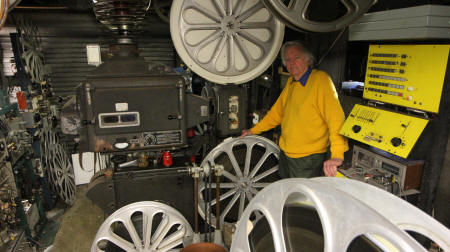 John
Mitchell next to his Cinerama installation. John
Mitchell next to his Cinerama installation.Click the image to see an enlargement Glendinning: Tell us about your background, what is your occupation? Mitchell: I’m retired now but I spent most of my working life working in telecommunications starting as a temporary technicians assistant in 1964 and ultimately becoming a full time senior technicial officer. | More in 70mm reading: Cinerama unterm Sternenhimmel Interview with John Mitchell, Australia - gallery of older pictures Cinemiracle Cinerama In The Picture - Tom Down Under Internet link: lenardaudio.com |
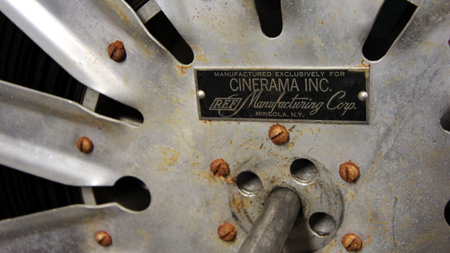 Cinerama
reel detail. Cinerama
reel detail.Originally starting in Wollongong for the Postmaster Generals office, later to be known as Australian Telecom and ultimately Telstra over the 26 years that I worked for them. My first job out of school was as a full time assistant projectionist at the Rose Bay Wintergarden, I also worked at the Gordon Kings before I moved to a small contry town called Bowral where I also worked at the local cinema. | |
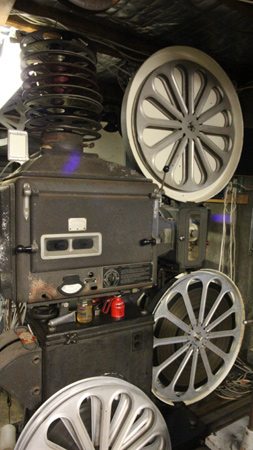 Baker Cinerama
projector. Baker Cinerama
projector.Even after I got my full time job I still worked for several years part time at the local Wollongong drive-in theatres in both Dapto and Fairy Meadow. Much later I also restored and operated the old Quirindri indoor / outdoor cinema in regional New South Wales for 20 years until 2008 . Glendinning: Why do you have 3 strip in your home and how long did it take to get all the films together before you could run it? Mitchell: It all started when I heard on the grapevine that a certain storehouse was to be emptied that contained a lot of the Cinerama films, these particular guys had conned people into thinking that they wanted to reuse the magnetic stock when in reality all they wanted to do was listen to the soundtracks. So I went along that night to see what was going on - well there was so much stuff there, all the soundtracks, half a print of “This Is Cinerama” that was used for practice purposes and four complete prints of "How The West Was Won". So they lugged all this stuff, they almost broke the truck that they had and for my trouble they gave me a complete print of "How The West Was Won", so that’s what enthused me into going and try to find the equipment to show it . | |
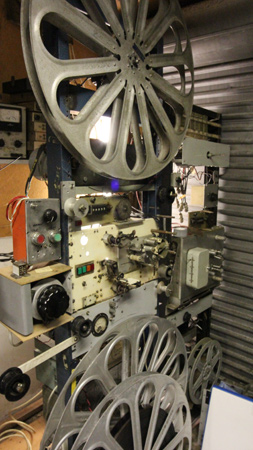 Cinerama
7-track sound dubber. Cinerama
7-track sound dubber.Unfortunately the prints had been badly stored and there was quite a bit of water damage. They had been standing in several inches of water at some stage or another. Anyway these were not technical people so I built them a simple machine to play back the soundtracks, after a couple of years they gave the whole lot to me anyway because they had to move and had no where to put it. Ultimately I was able to make one good print out of the four copies of "How The West Was Won". Glendinning: When did you install it and where did you find it? Mitchell: This all started in 1975 when I first got onto the films, it wasn’t until 1978 before I got them running. To do that I bought a couple of heads from a dealer named Allan Bourne from Associated Sound in Newcastle, I also sourced some projector heads from New Zealand. All along I knew that there were still a couple of complete projectors sitting in the former Sydney PLAZA theatre, the A and C machines. I had heard that the then lease holder Maxy’s coffee lounge/ disco wanted to put one of the machines on display in the foyer, so I went in there and offered my services. Moving one machine down to the foyer, I managed to acquire a few bits I needed for my installation which they did not need for their cosmetic display. | |
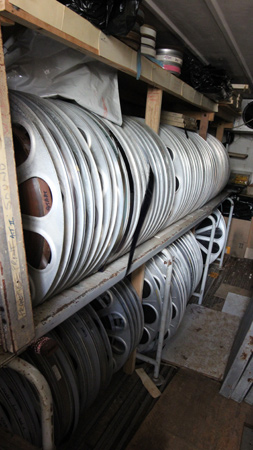 John
Mitchell's Cinerama print storage. John
Mitchell's Cinerama print storage.Several years later after Maxys folded, they were now converting the former Cinerama theatre into a roller skating ring and they needed to remove the two side projection rooms as they needed straight walls for their application. Essentially they were putting it back as it was originally but it also meant that the last projector had to go. I was driving past one day and I saw building work going on there so I went in and saw the construction manager and asked what was happening with the machine. “Well if Hoyts don’t show any interest it will be going to the tip in a few days time”. “I’ll buy it off you” I said , “So what’s it worth?” he asked, “ $50” I replied, “If that’s all it’s worth just take it, make sure it’s out before Monday!”. That was the only time I got a complete machine still in its original working condition and that’s my centre machine out the back now. I got other bits and pieces over the years, I managed to complete "This is Cinerama" and get a few more prints. My original prologue was on 16mm which was a copy of one that I borrowed. 30 years later my collection is almost everything to do with Cinerama and Cinemiracle, except for the breakdown film for "Seven Wonders of the World" and “Windjammer” (which is something I only recently found out even existed!). | |
 Charlie Cinerama
projector. Charlie Cinerama
projector.These films were never meant to be seen, they were on hand in case of a technical problem. Also absent from my collection is "Russian Adventure" which was filmed in the Russian Kinopanorama format and had an extremely limited 3-strip Cinerama release. Glendinning: Where does this fascination of the curved screen come from? Mitchell: Not sure, in 1958 as a child I went to the Sydney Plaza theatre to see “This is Cinerama”, as I moved to the country shortly after it was years later that I also experienced “How The West was Won” on the huge screen. They were the only Cinerama films I saw during their original release. | |
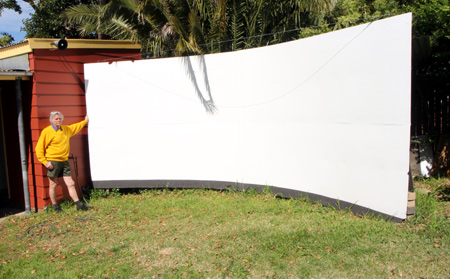 John
Mitchell next to his Cinerama screen. John
Mitchell next to his Cinerama screen.Glendinning: Can you give us an idea about screen size, projection throw and seating? Mitchell: 20’ x 8’screen, throw would be around 30’, capacity would be around 20 people in the open air theatre. | |
 Friends
watching 3-strip Cinerama in John 's open air cinema. Friends
watching 3-strip Cinerama in John 's open air cinema.Glendinning: Have you had many special visitors turn up? Mitchell: Two of the actors Harald Tusberg and Sven-Erik Libaek from "Windjammer" came here complete with a Norwegian tv crew, and more recently Otto Lang the Director of “Search for Paradise” - the 4th Cinerama film, who was 94 at the time and came all the way from Seattle on a cruise ship to see it here. Various cast and crew of "South Seas Adventure" including the North Bondi lifesavers who maned the boat that capsized in the surf. | |
 3-strip Cinerama
projected on the curve. Note the much loved 2 join lines (loved by Cinerama
enthusiasts that is). 3-strip Cinerama
projected on the curve. Note the much loved 2 join lines (loved by Cinerama
enthusiasts that is).Glendinning: Your home theatre what equipment do you have? Mitchell: Inside JBL 15” studio monitor speakers, 35mm, 70mm, 3D, silver or white screens, Dolby CP55 processor and I recently added a high definition 1080p video projector and Blu-ray to the mix. | |
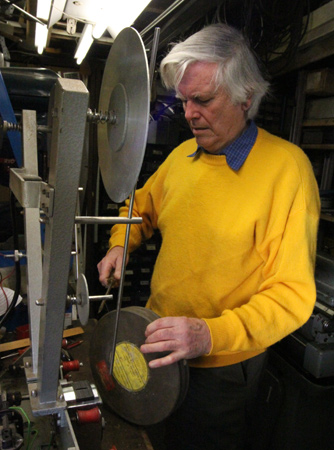 John
Mitchell working at his rewind system. John
Mitchell working at his rewind system.Glendinning: First screening? Mitchell: “This is Cinerama” with the 16mm prologue that I had at the time, That fist year because it’s open air I only had a limited 3 month season, we ran a film every fortnight over that summer. Never did that again, two to three sessions a year for the next 30 years. Recently it has slowed now just one screening every couple of years now that both the prints have I have aged. | |
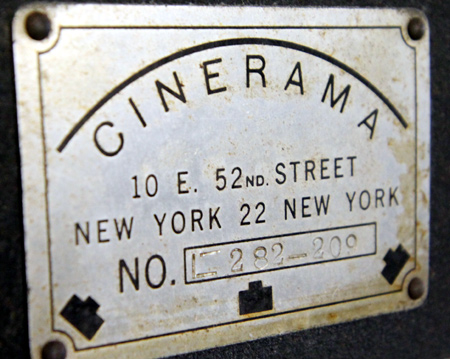 Cinerama
Inc plate. Cinerama
Inc plate.Glendinning: Any advice for others before they build their own Cinerama cinema? Mitchell: Don’t! Now that the prints are so old I think you missed your opportunity. Over the years most of the soundtracks have succumb to vinegar syndrome, as the magnetic coating is a catalyst for the breakdown of the 35mm film base. I have only just kept on top of this through copying due to the huge expense, typical cost for the stock is US$5000 per feature. Another serious cost is the constant air conditioning required to store the films in Sydney’s climate, including the electricity, maintenance and degassing. | |
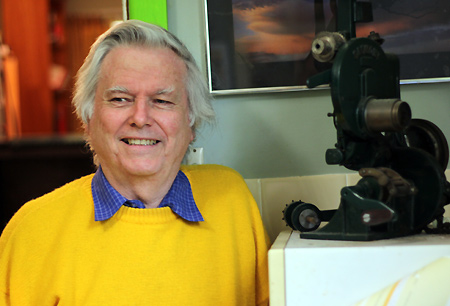 John
Mitchell next to a projector. John
Mitchell next to a projector.Glendinning: Thank you for your time, enthusiasm, and the work you has done to preserve Cinerama into the 21st century Mitchell: Due to the work of myself, Gunther Jung, John Sittig, John Harvey, Willem Bouwmeester, Dave Strohmaier and so many others who have preserved the Cinerama legacy, we now have such high quality Blu-rays on the way, which will allow us to watch these films on a big screen digitally. | |
| Go: back - top - back issues - news index Updated 22-01-25 |
